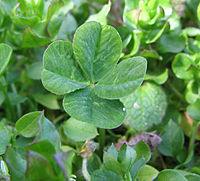Four-leaf clover

The four-leaf clover is a rare variation of the common three-leaf clover. Traditionally it is a common activity for children to look for these and it is considered good luck to find one.
People who search for four-leafed clovers note that some patches of ground appear more likely to contain four-leafed examples and that this may be partly due to differing growing conditions such as pollution, soil composition, and other environmental factors. According to the Guinness Book of World Records, the highest number of leaves found on a clover has been eighteen. It has been estimated that there are approximately 10,000 three-leaf clovers for every four-leaf clover.
According to legend, each leaf of the clover represents something. The first leaf is for hope, the second leaf is for faith, the third leaf is for love, and the fourth leaf, naturally, is for luck.[1]
There is a debate as to whether the four-leaf clover is caused by genetic or environmental factors. The rarity of the four leaf clover suggests a possible recessive gene at a low frequency as the cause. Alternatively, four-leaf clovers could be caused by a somatic mutation or a developmental error of environmental causes. The condition could also be caused by the interaction of several genes that happen to segregate in the individual plant. It is possible that all four explanations could apply to individual cases.
Oxalis tetraphylla, a species of wood sorrel that has four leaves, is sometimes misleadingly sold as "four-leaf clover", taking advantage of the mystical status of four-leaf clovers.
See also
- 4-H emblem
- Rabbit's foot
- Horseshoe
- Cloverleaf interchange
- Shamrock
- quattrofolium [2]
- Quatrefoil, a four-lobed structure.
- Cloverleaf or Quadrifoglio badges denote variants of Alfa Romeo cars where the name denotes the high-end of the range in comfort and engine size, but previously denoted Alfa Romeo racing cars in the pre-Second-World-War era.
